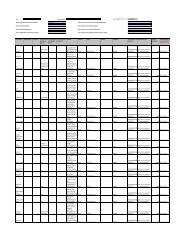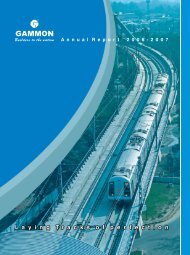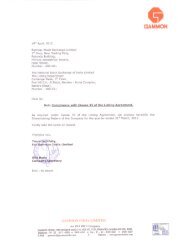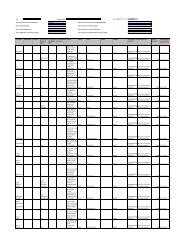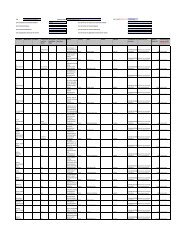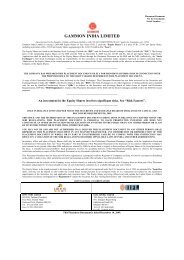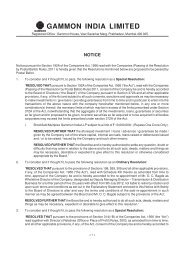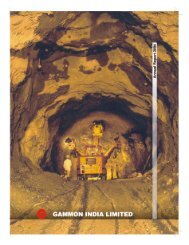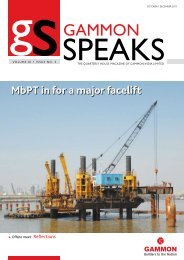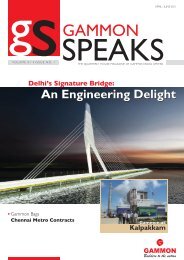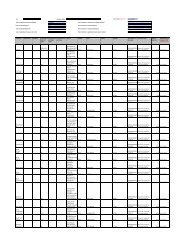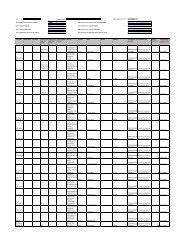Annual Report 2010-2011 - Gammon India
Annual Report 2010-2011 - Gammon India
Annual Report 2010-2011 - Gammon India
You also want an ePaper? Increase the reach of your titles
YUMPU automatically turns print PDFs into web optimized ePapers that Google loves.
The operative margin for financial year <strong>2010</strong> is comparable to 2009 if the impact of Port Sudan Project is<br />
not considered. Also a substantial reduction of overall risk funds for Euro 4.2 million has been a significant<br />
achievement of Project Management in <strong>2010</strong>. The year also started with streamlined global procurement<br />
activity and its full benefit will be in the years to come. The financial year <strong>2010</strong> closed with a negative result of<br />
Euro 15.583K in comparison to a positive result of Euro 176K of 2009.<br />
The implementation of the plan involving activities to improve performance of production is in progress, with<br />
the aim to (i) Reduce costs, (ii) Improve Quality and (iii) Improve the service granted to the Client. Continuous<br />
reduction in costs is being pursued through optimization of the high value activities carried out in the shops,<br />
the continuous analysis of production activities the adoption of a lean manufacturing organization and layout<br />
revision.<br />
SAE Power Lines S.r.L.:<br />
The activities of the Company relating to the fabrication and erection of transmission towers and lines continues<br />
to be steady with adequate and promising prospects as we look ahead. This is despite the pressure on liquidity<br />
in the global markets which would also have an impact in the emerging markets. However the prospects of good<br />
opportunities over the medium to long-term especially in markets in North East and West Africa are encouraging<br />
as also in the emerging markets including <strong>India</strong>, Brazil and the Middle East. The Company is continuing its focus<br />
on good market opportunities in the United States of America as well as Mexico for the future for all its products<br />
and services.<br />
During the calendar year <strong>2010</strong>, the Company recorded a turnover of Euro 32.02 million, an EBITDA of Euro 1.96<br />
million and PAT of Euro 4.60 million.<br />
Further, the year end order book was Euro 56 million. Additionally the company is well positioned on its bids<br />
which are approximately in the range of Euro 55 million.<br />
Oil and Gas - Campo Puma Oriente S.A.:<br />
The Puma Block is located in Ecuador’s Oriente Basin, 50 km south of Puerto Francisco de Orellana approximately<br />
400 Km east of Quito awarded to Pegaso Consortium (<strong>Gammon</strong> <strong>India</strong> Limited through Campo Puma Oriente<br />
S.A. has a share of 66.4% in the consortium). The contract was originally established as a Production Sharing<br />
Contract, which entitled the contractor to a share on the incremental production above an established base<br />
production output. After a reform on the Hydrocarbon Law on <strong>2010</strong>, all operators in Ecuador had to undergo a<br />
contract renegotiation process to migrate to the newly established Service Contract model. The revised Puma<br />
Block contract was signed and registered on February 1st, <strong>2011</strong> for an 18 year term. The primary objective of the<br />
project is the exploration, development, and production of hydrocarbons in the Puma Block through a Service<br />
Contract signed with the Ecuadorian government. From the beginning of the Block’s development in late 2008,<br />
90% of all production facilities have been built and are currently in operation; 7 wells have been drilled and are<br />
currently producing with a 100% success rate on development well drilling. Puma Block is currently producing an<br />
average of 1,800 barrels of oil per day. 15 km. of 2D seismic were surveyed during late <strong>2010</strong>, which will provide<br />
for valuable information regarding the reservoir currently in production. Based on this information, 2 additional<br />
development wells will be drilled between late <strong>2011</strong>, and early 2012 to increase production.<br />
The total investment plan for the initial stage of Puma Block’s exploration and development (2008 – 2015) is<br />
USD 100.6 million Out of the total project cost described in the previous section, the Consortium has invested<br />
USD 49.9 million as of December 31st, <strong>2010</strong>.<br />
The estimated production output for the Puma Block’s current developed and producing field is 1,800 barrels<br />
per day for the remaining contractual term (<strong>2011</strong> – 2028), is a total recovery of 11 million barrels. This implies a<br />
20% recovery factor over a total 50 million barrels estimated Original Oil in Place. This development considers<br />
9 currently drilled wells plus 2 additional development wells. At a Service Fee of $21.1/barrel, as established in<br />
the new Service Contract, the total resource pool created by the project is $232 million.<br />
9. Real Estate Business:<br />
Real estate, a “sunshine industry” in <strong>India</strong>, is flourishing rapidly, propelled by strong demand drivers and<br />
significant transformations such as deregulation of the sector, increasing transparency and professionalism,<br />
improved product quality and service standards etc.<br />
Further, the housing sector has been growing at an average of 34% annually, while the hospitality industry<br />
witnessed a growth of 10-15% last year. Apart from the huge demand, <strong>India</strong> also scores on the construction<br />
A NNUAL R EPORT I <strong>2010</strong>/11<br />
55





